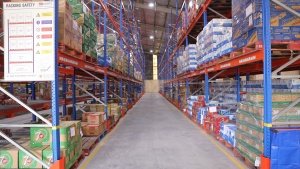Logistic predictions in 2024
 |
| Le Khanh Lam, partner, RSM Vietnam |
Significant changes will occur in logistics and commerce in 2024. As a result, it is crucial to prepare for these transformations and distinguish yourself from competitors. With the increasing use of AI, automation, and real-time visibility, staying up to date with the latest logistics trends and focusing on improving your supply chain is essential.
Challenges for logistic companies
The logistics and third-party logistics (3PL) industry is facing a significant challenge: a persistent global labour shortage. This shortage significantly impacts the production and delivery of goods, leading to increased costs.
To address this issue, manufacturers and logistics providers are turning towards automation. Warehousing processes are increasingly being automated, with machines now responsible for picking products and initiating packing. In the face of labour shortages, logistics companies must optimize their teams.
Furthermore, it is imperative to keep up with rapid technological advancements because neglecting to integrate new technologies promptly can have serious consequences. Notwithstanding inadequate technological capabilities, the costs and time involved in implementing new systems can put businesses at risk of falling behind in today's fast-paced world.
On the other hand, supplier networks are becoming increasingly complex. This is due to the expanding global marketplace, changing consumer demands, and the need for cost efficiency, all of which have contributed to the proliferation of supplier relationships. As the network grows, it becomes more vulnerable to disruptions from global events. Managing relationships and ensuring quality standards become progressively more challenging.
Understanding that these challenges can present opportunities for growth and improvement can help businesses increase profitability, customer satisfaction, and operational efficiency, thus placing them in a better position for success.
Four logistics trends that you should know
AI applied to logistics
AI will play an important role in the supply chain in 2024. AI-powered software engineering will be improved, enabling autonomous code generation and translating outdated programming languages.
Engineers can now devote more energy to innovative and imaginative work by minimizing the time spent on monotonous tasks.
This will boost their productivity and encourage them to come up with innovative solutions to complex problems.
The benefits of AI will extend beyond the R&D and IT departments and make it easier to access internal and external information.
Integrating automated systems in internal goods transport, storage, and handling operations is one of the most efficient ways to expedite logistics operations.
Robots are an excellent example of a powerful ally for dealing with peak demand at significant promotional events like Black Friday.
These devices can autonomously select and precisely place products through deep learning. They can complete up to thousands of picks per hour, making them highly efficient and effective for handling large orders.
AI can analyse data from sensors and maintenance records to predict when equipment and vehicles might fail or require maintenance.
Predictive maintenance is a preventative measure that helps to avoid unexpected downtimes and extend the lifespan of equipment.
Additionally, AI can optimize delivery routes by analysing real-time traffic conditions, weather, and other variables. This ensures that goods are delivered via the most efficient and fastest route, saving fuel and time.
B2B e-commerce expansion
B2B e-commerce, or business-to-business e-commerce, involves online transactions between organisations instead of B2C (business-to-consumer) transactions with individuals.
B2B e-commerce is rising as companies seek the same convenience and efficiency in retail shopping.
Online wholesale retailers are utilising marketplaces and subscription models to meet the demand. With digital solutions, organisations can synchronise their logistics centres with various online sales platforms, offering a seamless user experience.
Fast deliveries
As customer expectations continue to rise, organisations are competing to achieve faster shipping times.
This has resulted in the need to modify traditional logistics processes. Retailers are setting up more regional warehouses, parcel drop-offs, and collection points and implementing an omnichannel strategy that allows customers to return items to locations other than the point of purchase.
The ultimate goal is to provide agility, making it essential to optimise business intralogistics operations.
Ecosystem integrated implementation
Logistics companies are using more applications and platforms in their digital ecosystems than ever, creating a need for a seamless tool to integrate all their internal and external systems.
Ecosystem integration is the solution to this problem. Combining B2B and EDI with application integration and secure file transfer technologies integrates a company's critical revenue-generating business processes with its ecosystem partners via a single software platform.
Companies can reduce integration complexities and minimise errors by simplifying processes and connections by using one comprehensive integration platform instead of multiple solutions to integrate various platforms and trading partners.
Additionally, ecosystem integration tends to be less expensive than using multiple solutions. Finally, it allows for a better data flow between systems and companies as information can be shared in real time.
Trading partners and business leaders are increasingly demanding access to more accurate data. Therefore, ecosystem integration is an excellent solution to meet these demands and achieve seamless integration between systems and companies.
 | FM Logistic will handle warehousing operations for gro24/7 Third-party logistics provider FM Logistic has been awarded a contract from gro24/7, one of the largest B2B e-commerce platforms in Vietnam, to provide warehousing and urban logistics services. |
 | Expert predictions on forex in 2024 Experts forecast a more moderate exchange rate movement in 2024 despite current stormy conditions. |
 | Heading into an enthralling 2024 Vietnam in 2023 could be most reminded for strengthening cross-border ties, pushing through new laws, or taking action to weather the storms created by trade issues, geopolitical conflict, inflation, and the post-pandemic landscape. CEOs, legal advisors, and directors across tech, banking, retail, real estate, and more reveal what they thought of the previous 12 months in Vietnam, and offer their projections for the barriers and boosts to come during the Year of the Dragon. |
What the stars mean:
★ Poor ★ ★ Promising ★★★ Good ★★★★ Very good ★★★★★ Exceptional
Related Contents
Latest News
More News
- Pivotal stage of growth paves way for rise in M&As (December 03, 2025 | 10:00)
- Positive projections for M&A interest from Thailand (December 03, 2025 | 09:40)
- Manifesting the first line of defence in cybersecurity (December 03, 2025 | 09:00)
- The transformational role AI can play in accounting arena (December 03, 2025 | 08:00)
- Unlocking 5G-AI potential in Singapore (December 03, 2025 | 08:00)
- Data-driven strategies vital for a fast-evolving nation (December 02, 2025 | 09:41)
- Policy to practice: how Vietnam can lead the region (November 26, 2025 | 16:03)
- Mobilising private capital at scale vital for climate battle (November 26, 2025 | 15:36)
- VILAF and Yoon & Yang launch Vietnam - Korea Practice Unit (November 26, 2025 | 15:16)
- Trademark disputes challenge foreign firms in Vietnam (November 24, 2025 | 15:30)

 Tag:
Tag:




























 Mobile Version
Mobile Version